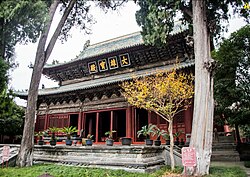Pingwu County
Pingwu County
平武县 | |
|---|---|
 Bao'en Temple in Pingwu County | |
 Location of Pingwu County (red) and Mianyang City (yellow) in Sichuan | |
| Coordinates: 32°24′36″N 104°33′22″E / 32.410°N 104.556°E | |
| Country | People's Republic of China |
| Province | Sichuan |
| Prefecture-level city | Mianyang |
| County seat | Long'an (龙安镇) |
| Area | |
| • Total | 5,974 km2 (2,307 sq mi) |
| Highest elevation | 5,588 m (18,333 ft) |
| Lowest elevation | 600 m (2,000 ft) |
| Population (2018) | |
| • Total | 180,000 |
| • Density | 30/km2 (78/sq mi) |
| Time zone | UTC+8 (China Standard) |
| Postal code | 622550 |
| Area code | 0816 |
| Website | pingwu |
Pingwu County (Chinese: 平武县; pinyin: Píngwǔ Xiàn) is a county located in the north of Sichuan province, China, bordering Gansu province to the north. It is the northernmost county-level division of the prefecture-level city of Mianyang.
It has an area of 5,959.71 km2 (2,301.06 sq mi)[1] and a population of 180,000 in 2018, making it one of the smallest counties by population in Sichuan.[2]
History
The history of Pingwu goes back over 1,700 years. In 108 CE, the Eastern Han established Guanghan County, which was ruled from present day Wen County. Beginning in the 3rd century CE, a number of kingdoms belonging to the Di tribe were set up in and around Pingwu County.[3] In 280 Pingwu County was first established. The name Pingwu originates from the name of the previous Yinping (阴平) and Guangwu (广武) counties.[2][better source needed]
In 347, Pingwu became part of the Eastern Jin.[2][better source needed]
By the 6th century, the Di kingdoms saw their power wane, and much of the area surrounding present-day Pingwu County was integrated into the Yarlung dynasty.[3] Despite this, the area of contemporary Pingwu County was not occupied by the Yarlung dynasty during the 7th century, resulting in a linguistic identity more akin to that of the Di tribe.[3]
Geography and Climate
Pingwu is a mountainous county located along the upper reaches of the Fujiang river, in the far northwest of the Sichuan Basin. 94% of the county's area is above 1,000 m elevation.[4][better source needed] The average yearly temperature is 14.7 °C (58.5 °F).[2][5]
| Climate data for Pingwu (1981−2010) | |||||||||||||
|---|---|---|---|---|---|---|---|---|---|---|---|---|---|
| Month | Jan | Feb | Mar | Apr | May | Jun | Jul | Aug | Sep | Oct | Nov | Dec | Year |
| Mean daily maximum °C (°F) | 9.4 (48.9) |
11.6 (52.9) |
16.1 (61.0) |
22.0 (71.6) |
26.0 (78.8) |
28.3 (82.9) |
30.0 (86.0) |
29.0 (84.2) |
24.5 (76.1) |
19.9 (67.8) |
15.6 (60.1) |
10.6 (51.1) |
20.2 (68.5) |
| Mean daily minimum °C (°F) | 1.1 (34.0) |
3.5 (38.3) |
7.0 (44.6) |
11.3 (52.3) |
15.2 (59.4) |
18.4 (65.1) |
20.4 (68.7) |
19.9 (67.8) |
16.8 (62.2) |
12.6 (54.7) |
7.4 (45.3) |
2.2 (36.0) |
11.3 (52.4) |
| Average precipitation mm (inches) | 4.0 (0.16) |
6.8 (0.27) |
20.1 (0.79) |
46.3 (1.82) |
78.6 (3.09) |
94.8 (3.73) |
160.9 (6.33) |
178.9 (7.04) |
110.3 (4.34) |
46.5 (1.83) |
10.7 (0.42) |
2.5 (0.10) |
760.4 (29.92) |
| Source: National Meteorological Center of CMA[6] | |||||||||||||
Economy
Pingwu is a large production base of Shiitake and wood ear mushroom, with an output of 1.1 million kg in 2009.[7]
Administrative divisions

Pingwu County has six towns, two townships, and twelve ethnic townships.[8]
Towns
Pingwu County's six towns are Long'an, Gucheng, Xiangyan, Daqiao, Shuijing, and Jiangyouguan.[8]
Townships
Pingwu County's two townships are Gaocun Township and Bazi Township.[8]
Ethnic townships
Pingwu County has twelve ethnic townships, of which, four have been designated as Qiang ethnic townships, and eight have been designated as Tibetan ethnic townships.[8]
The county's ethnic townships are Suojiang Qiang Ethnic Township, Tucheng Tibetan Ethnic Township, Jiubu Qiang Ethnic Township, Kuoda Tibetan Ethnic Township, Huangyangguan Tibetan Ethnic Township, Huya Tibetan Ethnic Township, Si'er Tibetan Ethnic Township, Baima Tibetan Ethnic Township, Muzuo Tibetan Ethnic Township, Mupi Tibetan Ethnic Township, Doukou Qiang Ethnic Township, and Pingtong Qiang Ethnic Township.[8]
Demographics
Languages
Pingwu County is one of three counties in Sichuan where the Baima language is spoken.[9]
Attractions
Pingwu county is the center of the biggest remaining giant panda habitat in China, i.e. the Minshan Mountains. Close to the Baima Ethnic Township, for example, the national panda reserve "Wanglang" is located. The WWF has conducted an Integrated Community Development Project in the Baima township to reduce direct and indirect poaching threats to the panda population. A temple named "Baoensi" is also located there.
Fauna
There are two species of Megophryidae frogs endemic to Pingwu County, namely Scutiger pingwuensis and Oreolalax chuanbeiensis.
Notable residents
See also
References
- ^ (in Chinese) Geography of Pingwu County Archived 2008-11-23 at the Wayback Machine, Official website of Pingwu County Government, visited on May 14, 2008.
- ^ a b c d 网易 (2021-03-30). "四川省一县级市,人口仅18万,建县历史超1700年!". www.163.com. Retrieved 2021-05-08.
- ^ a b c Chirkova, Ekaterina (2005). "Words for 'one' in Baima" (PDF). Cahiers de Linguistique Asie Orientale. 34: 69–99. doi:10.1163/19606028-90000135. S2CID 170844236. Archived (PDF) from the original on 2021-08-22. Retrieved 2021-08-22 – via HAL (open archive).
- ^ 网易 (2021-03-30). "四川省一县级市,人口仅18万,建县历史超1700年!". www.163.com. Retrieved 2021-05-08.
- ^ "走进平武 - 平武县文广旅局". zww.zypingwu.com. Retrieved 2021-05-08.
- ^ 1981年-2010年(平武)月平均气温和降水 (in Simplified Chinese). National Meteorological Center of CMA. Retrieved 9 November 2022.
- ^ 中国农村科技 (in Chinese). 中国农村科技杂志社. 2009.
- ^ a b c d e 2020年统计用区划代码 [2020 Statistical Division Codes] (in Chinese). National Bureau of Statistics of China. 2020. Archived from the original on 2021-02-17. Retrieved 2021-02-17.
- ^ "Baima". endangeredlanguages.com. Endangered Languages Project. Retrieved 2021-02-17.
{{cite web}}: CS1 maint: url-status (link)
